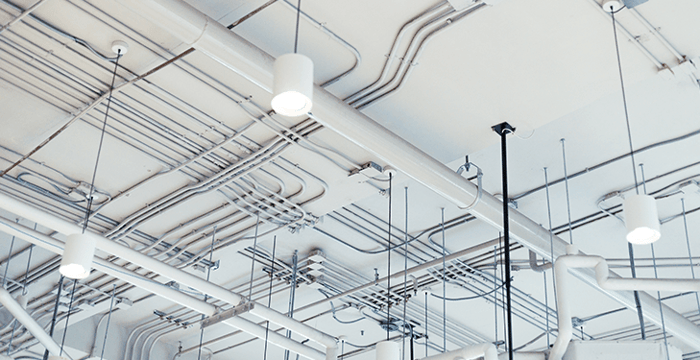Systems only work as well as they are designed.
This applies to low voltage infrastructure and technologies.
However, a poor-quality low voltage design often causes project costs to go up and inefficiencies to magnify. You see this when low voltage systems aren’t integrated with other systems in the same building. Or when there’s little coordination between electrical contractors and low voltage contractors on the same project.
Why Does Quality Low Voltage Design Matter?
Business executives worldwide count on their information systems like local area networks and building automation to help their companies compete in an ever-increasing competitive landscape.
Proper planning, design, installation, and maintenance of low voltage systems will make for a better experience for anyone who uses the network. A quality design will help your organization:
- Lower project costs - Getting it right the first time reduces the number of change orders, design revisions, and unexpected problems, all adding up to cost savings for you.
- Faster project completion - A reliable, quality low voltage design leads to successful installation and implementation. By minimizing the time spent on-site, your project gets completed quicker.
- Reliable systems - All of your technology relies on the low voltage infrastructure. A quality low voltage system minimizes disruptions and risks to your business’s critical systems.
Low Voltage Design Pitfalls
Pathways and spaces take a hit from a lack of coordination between electrical and low voltage contractors.
Typically the electrical contractor is responsible for providing the conduit systems for the low voltage cabling. This protocol makes sense because the electrical contractor is usually on-site before the low voltage installer, and they need the conduit for their power cables. Some conduit runs require special bends to navigate the internal areas in ceilings around and over ductwork and other architectural features.

Impressive conduit work.
Good conduit work resembles an art form in complex installations.
But when communication breaks down between low voltage contractors and other trades, the opposite occurs. Here are a few all too common challenges we see people encounter.
Conduit Space
Conduits run by the electrician don’t go to where they need to go and are undersized for the number of cables expected to go in them, given the conduit-fill ratio. This can be an expensive problem to fix.
Firewall Penetration
There’s supposed to be a penetration through a firewall, but the electrical contractor didn’t consider or prepare for the cables to get through it. Now what?
WAPs
Architects may have the wireless access point (WAP) drawn on the plans in one spot, but the cable got routed to another place. Changing either system after-the-fact can result in spotty coverage.
Security
Frequently, the people who frame the access control doors don’t know which side to place the magnetic strike. If the door is an exterior door and the exterior construction is a block or some other cement material, gaining access to the magnetic strike after installation can be challenging.
(Related: 5 Low Voltage Design Mistakes That Cost DOUBLE On the Backend)
Slab Floors
Tombstones and floor boxes are often times mounted on slab flooring that requires conduit to be run before the cement is poured for the floor. If the conduit is missing, the alternative is to cut a small trench in the cement to accommodate the conduit after the fact, significantly increasing costs.

Concrete trenching (Source: Principle Projects Ltd.)
We aren’t pointing fingers at anyone with these problems. Generally, the electrical contractor, architect, or technician is just doing what they’ve been asked to do.
But now you have big –and potentially costly– hurdles to overcome.
Hurdles and challenges that could be avoided with proactive management, quality low voltage design, and streamlined communication between trades.
Characteristics of Quality Low Voltage Design
John Persuitte, VP of Operations of Automated Systems Design, said that 70% of low voltage designs contain flaws that could have been avoided with the proper coordination between trades. Someone needs to communicate with the architect, general contractor, electrical contractor, and low voltage contractor, which rarely happens in a bid work scenario. Based on his 25 years of experience, John said, “Often, the workaround to accomplish the owner’s request is more costly and far less than optimal.”
So how can we avoid this? What makes a quality low voltage design different?
Coordination meetings between trades.
Before work begins, discussing needs and requirements will ensure that pathways and space line up with circuits drawn on the prints. Knowing where infrastructure needs to be before walls go up and cement is poured will reduce unnecessary costs and disruptions.
(Related: How Does ASD® Ensure Quality?)
The consultant providing the low voltage designs should use these coordination meetings as an opportunity to be the owner’s advocate. Only low voltage designers understand the importance of a complete and high-quality technology design. Discussing the different systems before construction begins gives designers the chance to identify potential issues and proactively address them.
Once the technology consultant has a thorough understanding of all the building’s systems, they can create a robust set of plans. A quality design construction set should be well-documented with notes and comments for all the systems in the scope, complete with room layouts, riser diagrams, equipment rack elevations, floor plans, and detail sheets.
Next Steps
Whether you’re thinking about a project for next quarter or in the midst of one getting derailed, bringing on a quality technology consultant will improve your low voltage systems 10X. The cost associated with a quality design is nothing compared to all of the change orders, redos, revisions, and installation problems you’ll encounter without one.
Get the results and deliverables you desire the first time around.
Interested in speaking with an RCDD about your next cabling project? Click here to contact us. We’re happy to answer any questions you may have.
If you want to learn more about structured cabling, download the purchasing guide below.
Editor's Note: This post was originally published in November, 2017 and has been updated for freshness, accuracy, and comprehensiveness.



Leave a Comment